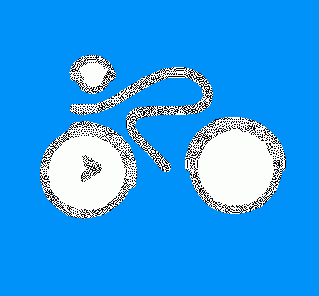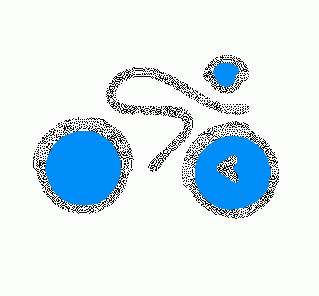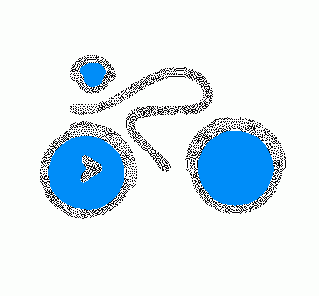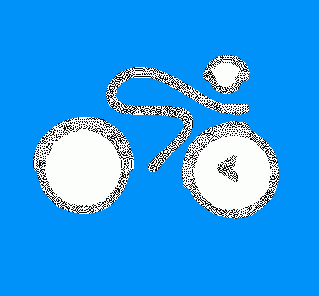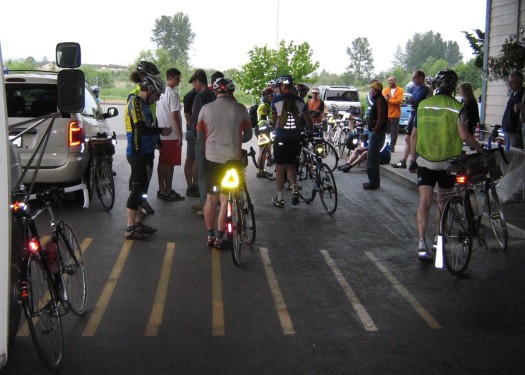
SIR 600 km Ride
Report
by Luis Bernhardt
Having done the first three brevets - from
200 km to 400 km - in BC, I decided to do the 600 km leg of my
fixed-gear Super Randonneur series in Washington. I had looked
at the BC course, and although it would be convenient to be able
to leave supplies in Abbotsford - a change of clothes and extra
food - the course looked mind-numbing: Out past Hope, up to Boston
Bar, back to Hope, all the way back to Coquitlam, back to Abbotsford,
back out to Hope… I didn't think I could take riding over
the same roads over and over again.
Washington had some nice features. Primarily,
it was a big loop going over roads I had never ridden, in an
area I'd always been interested in riding: rolling countryside
along the base of the Olympic Peninsula out to the ocean, winding
roads through southern Washington, light traffic, no crazy hors
categorie mountain passes (well, almost none, but this is an
SIR brevet). There were over thirty riders already preregistered
the week before the ride, growing to 58 by the day of the ride,
more than on the Lower Mainland 300 or 400. Cleverly, the organizer
set the route to head west in the early morning so the sun would
be at your back. By maintaining a 25 kmh average, you could be
well into eastbound by the time the sun was setting. And by sunrise
the next day, you'd have the sun either to your right as you
headed north, or behind you as you headed west again.
The interesting thing about the 600 is
that there is enough leeway in time that it can be ridden as
two one-day rides, as long as you maintain a 25 kmh average.
Day 1 is the typical 16-hour 400. The organizers had booked a
motel in Centralia, the 403-km point, where they would ferry
your clothing and supplies, so it was possible to actually spend
a restful night between 22h on Saturday and 6h on Sunday (the
control closes at 8h52), avoiding most of the night riding and
having fresh clothes for the next day's ride. Allowing 9 hours
for the final 200 km, you finish at 15h on Sunday, a nice 7-hour
buffer before the final deadline of 22h on Sunday night. (When
I did these rides back in the early 1980's, we just did the whole
thing in one shot, maybe stopping for a sit-down dinner along
the way. It was Dan McGuire who insisted on booking a motel and
sleeping!)
Or, you could just get the whole thing
over with in 24 hours. Part of the attraction of a brevet is
being alone on empty roads in the blackness of night with only
the small pool of light ahead of you and the sound of dogs barking
in the distance. Then magic happens in the early morning, as
light and warmth begin to infuse the scenery, and the body begins
to awaken from its nocturnal torpor. It's an indescribable feeling
experienced only by randonneurs, and maybe race car drivers at
LeMans during les 24 Heures.
Although the week had been sunny, it was
overcast at the start in Auburn. I had slept in the car, setting
the alarm for 4:15 so I'd have enough time to drive over to the
seedy 24-hour casino and have breakfast. The Vancouver forecast
for Seattle said possible showers, so I clipped on the fenders
and put some warmer clothes and shoe covers into my bag being
sent to the Centralia control.
The ride started at an easy tempo until
we reached the first long climb in Tacoma. I bridged up to the
front group with the assistance of some well-timed stoplights.
I think the best strategy for the longer brevets is to not make
any hard efforts at the beginning, when you're still feeling
good. The bridging to the front group was just climbing at my
own tempo up the long grade. I was disappointed that no one followed
me; it's nice to have a large group sharing the lead.
I'm often asked if it's hard to ride hilly
brevets on the fixed gear. Someone once said that a fixed gear
actually has two speeds: sitting and standing, and I'm inclined
to agree. Climbing is a good thing because you can get off the
saddle, especially in the latter stages of a 600 where the hard
part becomes descending. With the legs moving fast and the bike
pointed downward, the pain on the sit bones and associated tissue
can be excruciating! One of my projects prior to P-B-P 2011 will
be finding an uber-comfortable saddle. The San Marco Era is fine
to about 300 km, then it starts to become painful, even with
a change of shorts. I absolutely refuse to ride Brooks saddles;
I've tried them and they don't work for me.
Some of the arrogant older riders, and
I mean the old guys from England (but certainly not Harold, who
has more class), tell me I'm crazy to ride the fixed gear. I
think the fixie keeps you from getting too fixated on equipment.
I'm on an old (1989) steel track frame made in Mexico, albeit
with all carbon forks and seat post, and I'm keeping up with
dudes on expensive full carbon 20-speed bikes with Ksyrium wheels.
Easily keeping up. You just don't need all that equipment the
corporations seduce you into buying and then incrementally improving
the next year so you have to continuously upgrade. Besides, I
know I can finish the ride with gears; riding it fixed at least
makes it a challenge. And this is my way of honoring the truly
hard men of cycling, the guys who rode P-B-P years ago on fixed
because that's all there was.
An unexpected highlight of the morning
was the crossing of the new Tacoma Narrows Bridge, with the separated
bike path along one side, much like over Seattle's I-90 bridge.
It was a cool morning, but the moderate
tempo kept us warm through Gig Harbor, Port Orchard, and along
the Hood Canal, where the wind started to pick up. We rode into
a headwind over low-traffic, high-texture state routes out toward
the ocean at Westport. We lost a few riders from attrition, but
ended with six riders by the time we reached bustling Cosmopolis.
One of the unique features of this particular
brevet was the spacing of the controls. We signed in at Waterman
Point, on Rich Passage, at km 84, and the next control was Cosmopolis,
near Grays Harbor, at km 237! The control after that was Westport,
km 266. After 106 km, the next two controls were Rainbow Falls
State Park followed by Centralia, 33 km apart. And at the finish,
the penultimate control at Enumclaw was only 28 km from the finish
in Auburn.
It was a cool day, so I didn't drink much
on the bike, and being pulled along by the group, I didn't feel
like eating until the afternoon. I carried my usual Subway ham
sub with lettuce, tomatoes, and olives. I should have switched
from Gatorade to V-8 earlier, as I started cramping after nine
hours.
At the left turn at Raymond, we were into
the tailwind stretch. On a fixie, this is actually harder in
a group, as the speed picks up and you have to spin faster to
keep up. But a 100-110 rpm tempo is not a problem, and the scenery
beats circling a velodrome.
We hit the sign for Rainbow Falls State
Park and turned left, but there was no control. We continued
on the road for about two more km before a couple of the smarter
riders figured out that there was probably a main park entrance
further up the road. So we turned around, got back on the main
road, and just booted it until we arrived at the proper control.
I understand groups behind us had the same problem, some of them
even going to the end of the faux road. Kind of depressing if
it's the middle of the night. It was still light, we had some
warm food, and we proceeded to the overnight control at Centralia
about an hour away.
After cleaning up and changing into fresh
shorts and socks, the four of us who would ride through the night
set off: Ryan Hamilton, Thomas Martin, Matthew Newlin, and me.
It was after 10 pm and dark, and it was weird riding up the long
grades along Centralia Alpha, not being able to see how much
higher the road climbed. There were just the small pools of light
formed by our headlights, some of them flashing and swooping
back and forth like fireflies. I could see why it's not a good
idea to use flashing lights in a group at night; I tend to agree
with the Germans, who don't permit flashing lights on bikes;
too jarring sitting behind one. We were in Morton after midnight,
with another long climb immediately afterwards. Our 25 kmh average
kept dropping as the road climbed; I was resigned to finishing
around 8 am, but at least the climbs were not steep and they
gave me an opportunity to get out of the saddle. I could feel
pain developing behind my left knee, and two days later, I would
see a swollen right Achilles tendon from overuse. But for now,
I was enjoying the music of the night. The important thing was
to stay with the group, since I had forgotten to bring my spare
battery-light with which to read the cue sheet in the dark, so
to avoid navigation problems, I needed to avoid getting dropped!
At dawn we finally reached the penultimate
control in Enumclaw. Dawn was breaking, scenery was becoming
visible, but that darned road kept winding on and on with no
Enumclaw in sight. This was probably the most difficult part
of the ride. I was considering dropping back and letting the
three stronger riders finish ahead, but I was still within my
limits, and I didn't feel like pulling out the cue sheet and
trying to navigate, so I just hung on until the control. We left
the Enumclaw control just after 5:30, riding the final hour easily
- it was either flat or descending - with one overpass to climb.
We arrived at the finish in Auburn at 6:44, better than I had
expected. And then the perennial question for P-B-P: I've done
600 km, do I still have another 600 in me?
Luis Bernhardt
has been racing bicycles on the road and track since 1972. He
has won medals in US and Canadian nationals, and at the World
Masters Track Championships and World Masters Games, as well
as stage races in Mexico and Guatemala, and track races in the
Caribbean. He won overall in his age group at the Huntsman World
Senior Games in 2005. He commutes to work on the same fixed gear
bike he used for this year's randonneur series, and he enjoys
driving a tandem. Luis was also one of the first BC Randonneurs
back in the early 1980s.
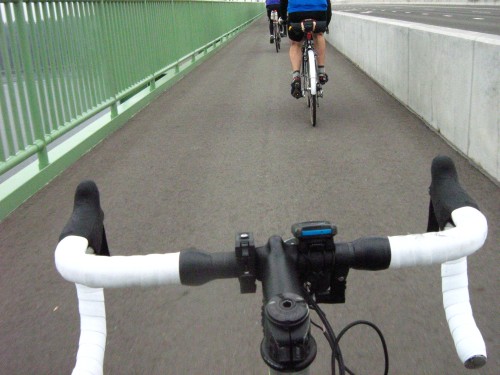
June 23, 2009 |
